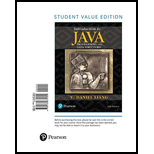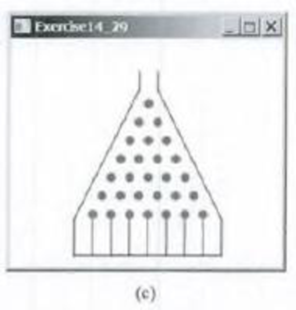
Introduction to Java Programming and Data Structures, Comprehensive Version, Student Value Edition (11th Edition)
11th Edition
ISBN: 9780134671604
Author: Y. Daniel Liang
Publisher: PEARSON
expand_more
expand_more
format_list_bulleted
Concept explainers
Textbook Question
Chapter 14, Problem 14.29PE
(Game: bean machine) Write a program that displays a bean machine introduced in

Expert Solution & Answer
Want to see the full answer?
Check out a sample textbook solution
Students have asked these similar questions
Solve in MATLAB
Hello please look at the attached picture. I need an detailed explanation of the architecture
Information Security Risk and Vulnerability Assessment
1- Which TCP/IP protocol is used to convert the IP address to the Mac address? Explain 2-What popular switch feature allows you to create communication boundaries between systems connected to the switch3- what types of vulnerability directly related to the programmer of the software?4- Who ensures the entity implements appropriate security controls to protect an asset?
Please do not use AI and add refrence
Chapter 14 Solutions
Introduction to Java Programming and Data Structures, Comprehensive Version, Student Value Edition (11th Edition)
Ch. 14.2 - Explain the evolution of Java GUI technologies.Ch. 14.2 - Prob. 14.2.2CPCh. 14.3 - Prob. 14.3.1CPCh. 14.3 - Show the output of the following JavaFX program:...Ch. 14.4 - How do you create a Scene object? How do you set a...Ch. 14.4 - Prob. 14.4.2CPCh. 14.4 - Prob. 14.4.3CPCh. 14.4 - How do you replace the code in lines 20 and 21 in...Ch. 14.5 - Prob. 14.5.1CPCh. 14.5 - Prob. 14.5.2CP
Ch. 14.5 - Can you create an object of IntegerProperty using...Ch. 14.5 - Prob. 14.5.4CPCh. 14.6 - Prob. 14.6.1CPCh. 14.6 - Prob. 14.6.2CPCh. 14.7 - How do you create a color? What is wrong about...Ch. 14.7 - Prob. 14.7.2CPCh. 14.7 - Prob. 14.7.3CPCh. 14.8 - Prob. 14.8.1CPCh. 14.8 - Prob. 14.8.2CPCh. 14.9 - Prob. 14.9.1CPCh. 14.9 - Prob. 14.9.2CPCh. 14.9 - Prob. 14.9.3CPCh. 14.10 - Prob. 14.10.1CPCh. 14.10 - Prob. 14.10.2CPCh. 14.10 - Prob. 14.10.3CPCh. 14.10 - Prob. 14.10.4CPCh. 14.10 - Prob. 14.10.5CPCh. 14.11 - How do you display a text, line, rectangle,...Ch. 14.11 - Prob. 14.11.2CPCh. 14.11 - Prob. 14.11.3CPCh. 14.11 - Write code fragments to fill red color in a...Ch. 14.11 - Prob. 14.11.5CPCh. 14.11 - Prob. 14.11.6CPCh. 14.11 - Write code fragments to display the outline of the...Ch. 14.11 - Write code fragments to display the lower half of...Ch. 14.11 - Write code fragments to display a polygon...Ch. 14.11 - Write code fragments to display a polygon...Ch. 14.11 - Prob. 14.11.11CPCh. 14.12 - Prob. 14.12.1CPCh. 14 - Prob. 14.1PECh. 14 - Prob. 14.2PECh. 14 - (Display three cards) Write a program that...Ch. 14 - (Color and font) Write a program that displays...Ch. 14 - (Characters around circle) Write a program that...Ch. 14 - Prob. 14.6PECh. 14 - (Display random 0 or 1) Write a program that...Ch. 14 - (Create four fans) Write a program that places...Ch. 14 - (Display a cylinder) Write a program that draws a...Ch. 14 - Prob. 14.11PECh. 14 - (Display a bar chart) Write a program that uses a...Ch. 14 - Prob. 14.13PECh. 14 - (Display a rectanguloid) Write a program that...Ch. 14 - Prob. 14.15PECh. 14 - Prob. 14.16PECh. 14 - (Game: hangman) Write a program that displays a...Ch. 14 - Prob. 14.18PECh. 14 - (Plot the sine and cosine functions) Write a...Ch. 14 - (Draw an arrow line) Write a static method that...Ch. 14 - Prob. 14.21PECh. 14 - (Connect two circles) Write a program that draws...Ch. 14 - (Geometry: two rectangles) Write a program that...Ch. 14 - (Geometry: Inside a polygon?) Write a program that...Ch. 14 - Prob. 14.25PECh. 14 - Prob. 14.27PECh. 14 - (Random time) Modify the ClockPane class with...Ch. 14 - (Game: bean machine) Write a program that displays...
Knowledge Booster
Learn more about
Need a deep-dive on the concept behind this application? Look no further. Learn more about this topic, computer-science and related others by exploring similar questions and additional content below.Similar questions
- Could you help me to know features of the following concepts: - commercial CA - memory integrity - WMI filterarrow_forwardBriefly describe the issues involved in using ATM technology in Local Area Networksarrow_forwardFor this question you will perform two levels of quicksort on an array containing these numbers: 59 41 61 73 43 57 50 13 96 88 42 77 27 95 32 89 In the first blank, enter the array contents after the top level partition. In the second blank, enter the array contents after one more partition of the left-hand subarray resulting from the first partition. In the third blank, enter the array contents after one more partition of the right-hand subarray resulting from the first partition. Print the numbers with a single space between them. Use the algorithm we covered in class, in which the first element of the subarray is the partition value. Question 1 options: Blank # 1 Blank # 2 Blank # 3arrow_forward
- 1. Transform the E-R diagram into a set of relations. Country_of Agent ID Agent H Holds Is_Reponsible_for Consignment Number $ Value May Contain Consignment Transports Container Destination Ф R Goes Off Container Number Size Vessel Voyage Registry Vessel ID Voyage_ID Tonnagearrow_forwardI want to solve 13.2 using matlab please helparrow_forwarda) Show a possible trace of the OSPF algorithm for computing the routing table in Router 2 forthis network.b) Show the messages used by RIP to compute routing tables.arrow_forward
- using r language to answer question 4 Question 4: Obtain a 95% standard normal bootstrap confidence interval, a 95% basic bootstrap confidence interval, and a percentile confidence interval for the ρb12 in Question 3.arrow_forwardusing r language to answer question 4. Question 4: Obtain a 95% standard normal bootstrap confidence interval, a 95% basic bootstrap confidence interval, and a percentile confidence interval for the ρb12 in Question 3.arrow_forwardusing r languagearrow_forward
arrow_back_ios
SEE MORE QUESTIONS
arrow_forward_ios
Recommended textbooks for you
 C++ Programming: From Problem Analysis to Program...Computer ScienceISBN:9781337102087Author:D. S. MalikPublisher:Cengage Learning
C++ Programming: From Problem Analysis to Program...Computer ScienceISBN:9781337102087Author:D. S. MalikPublisher:Cengage Learning C++ for Engineers and ScientistsComputer ScienceISBN:9781133187844Author:Bronson, Gary J.Publisher:Course Technology Ptr
C++ for Engineers and ScientistsComputer ScienceISBN:9781133187844Author:Bronson, Gary J.Publisher:Course Technology Ptr Microsoft Visual C#Computer ScienceISBN:9781337102100Author:Joyce, Farrell.Publisher:Cengage Learning,
Microsoft Visual C#Computer ScienceISBN:9781337102100Author:Joyce, Farrell.Publisher:Cengage Learning, EBK JAVA PROGRAMMINGComputer ScienceISBN:9781337671385Author:FARRELLPublisher:CENGAGE LEARNING - CONSIGNMENT
EBK JAVA PROGRAMMINGComputer ScienceISBN:9781337671385Author:FARRELLPublisher:CENGAGE LEARNING - CONSIGNMENT

C++ Programming: From Problem Analysis to Program...
Computer Science
ISBN:9781337102087
Author:D. S. Malik
Publisher:Cengage Learning

C++ for Engineers and Scientists
Computer Science
ISBN:9781133187844
Author:Bronson, Gary J.
Publisher:Course Technology Ptr

Microsoft Visual C#
Computer Science
ISBN:9781337102100
Author:Joyce, Farrell.
Publisher:Cengage Learning,

EBK JAVA PROGRAMMING
Computer Science
ISBN:9781337671385
Author:FARRELL
Publisher:CENGAGE LEARNING - CONSIGNMENT
Literals in Java Programming; Author: Sudhakar Atchala;https://www.youtube.com/watch?v=PuEU4S4B7JQ;License: Standard YouTube License, CC-BY
Type of literals in Python | Python Tutorial -6; Author: Lovejot Bhardwaj;https://www.youtube.com/watch?v=bwer3E9hj8Q;License: Standard Youtube License